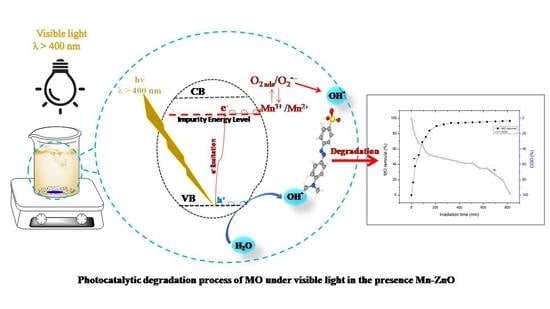Structural, Optical and Photocatalytic Properties of Mn Doped ZnO Nanoparticles Used as Photocatalysts for Azo-Dye Degradation under Visible Light
Abstract
:1. Introduction
2. Results and Discussion
2.1. Characterization
2.1.1. XRD Results
2.1.2. FTIR Results
2.1.3. DRS Results
2.1.4. XPS Results
2.1.5. PL Results
2.1.6. SEM-EDS Results
2.2. Photocatalytic Studies
2.2.1. Evaluation of the Photocatalytic Activity
2.2.2. Effect of pH
2.2.3. Identification of the Active Species
2.2.4. Reusability
3. Materials and Methods
3.1. Materials
3.2. Methods
3.2.1. Synthesis of the Photocatalysts
3.2.2. Characterization of the Photocatalysts
3.2.3. Photocatalytic Tests
pH Effect
Identification of the Active Species
Procedure of the Photocatalyst Recovery and Recycling
4. Conclusions
Supplementary Materials
Author Contributions
Funding
Acknowledgments
Conflicts of Interest
References
- Golob, V.; Vinder, A.; Simonič, M. Efficiency of the Coagulation/Flocculation Method for the Treatment of Dye bath Effluents. Dye. Pigment. 2005, 67, 93–97. [Google Scholar] [CrossRef]
- Allegre, C.; Maisseu, M.; Charbit, F.; Moulin, P. Coagulation–Flocculation–Decantation of Dye House Effluents: Concentrated Effluents. J. Hazard. Mater. 2004, 116, 57–64. [Google Scholar] [CrossRef] [PubMed]
- Papić, S.; Koprivanac, N.; LončarićBožić, A.; Meteš, A. Removal of Some Reactive Dyes from Synthetic Wastewater by Combined Al(III) Coagulation/Carbon Adsorption Process. Dye. Pigment. 2004, 62, 291–298. [Google Scholar] [CrossRef]
- Aadnan, I.; Zegaoui, O.; Daou, I.; Esteves da Silva, J.C.G. Synthesis and Physicochemical Characterization of a ZnO-Chitosan Hybrid-Biocomposite Used as an Environmentally Friendly Photocatalyst under UV-A and Visible Light Irradiations. J. Environ. Chem. Eng. 2020, 8, 104260. [Google Scholar] [CrossRef]
- El Mragui, A.; Daou, I.; Zegaoui, O. Influence of the Preparation Method and ZnO/(ZnO + TiO2) Weight Ratio on the Physicochemical and Photocatalytic Properties of ZnO-TiO2 Nanomaterials. Catal. Today 2019, 321–322, 41–51. [Google Scholar] [CrossRef]
- Daou, I.; Zegaoui, O.; Elghazouani, A. Physicochemical and Photocatalytic Properties of the ZnO Particles Synthesized by Two Different Methods Using Three Different Precursors. Comptes Rendus Chim. 2017, 20, 47–54. [Google Scholar] [CrossRef]
- Pathak, T.K.; Coetsee-Hugo, E.; Swart, H.C.; Swart, C.W.; Kroon, R.E. Preparation and Characterization of Ce Doped ZnO Nanomaterial for Photocatalytic and Biological Applications. Mater. Sci. Eng. B 2020, 261, 114780. [Google Scholar] [CrossRef]
- Atta-Eyison, A.A.; Anukwah, G.D.; Zugle, R. Photocatalysis Using Zinc Oxide-Zinc Phthalocyanine Composite for Effective Mineralization of Organic Pollutants. Catal. Commun. 2021, 160, 106357. [Google Scholar] [CrossRef]
- Kusiak-Nejman, E.; Wojnarowicz, J.; Morawski, A.W.; Narkiewicz, U.; Sobczak, K.; Gierlotka, S.; Lojkowski, W. Size-Dependent Effects of ZnO Nanoparticles on the Photocatalytic Degradation of Phenol in a Water Solution. Appl. Surf. Sci. 2021, 541, 148416. [Google Scholar] [CrossRef]
- Benhebal, H.; Chaib, M.; Salmon, T.; Geens, J.; Leonard, A.; Lambert, S.D.; Crine, M.; Heinrichs, B. Photocatalytic Degradation of Phenol and Benzoic Acid Using Zinc Oxide Powders Prepared by the Sol–Gel Process. Alex. Eng. J. 2013, 52, 517–523. [Google Scholar] [CrossRef]
- Teo, H.L.; Wong, L.; Liu, Q.; Teo, T.L.; Lee, T.K.; Lee, H.K. Simple and Accurate Measurement of Carbamazepine in Surface Water by Use of Porous Membrane-Protected Micro-Solid-Phase Extraction Coupled with Isotope Dilution Mass Spectrometry. Anal. Chim. Acta 2016, 912, 49–57. [Google Scholar] [CrossRef] [PubMed]
- Miao, X.S.; Metcalfe, C.D. Determination of Carbamazepine and Its Metabolites in Aqueous Samples Using Liquid Chromatography−Electrospray Tandem Mass Spectrometry. Anal. Chem. 2003, 75, 3731–3738. [Google Scholar] [CrossRef]
- Mohapatra, D.P.; Brar, S.K.; Daghrir, R.; Tyagi, R.D.; Picard, P.; Surampalli, R.Y.; Drogui, P. Photocatalytic Degradation of Carbamazepine in Wastewater by Using a New Class of Whey-Stabilized Nanocrystalline TiO2 and ZnO. Sci. Total Environ. 2014, 485–486, 263–269. [Google Scholar] [CrossRef] [PubMed]
- Leucht, S.; Helfer, B.; Dold, M.; Kissling, W.; Mcgrath, J. Carbamazepine for Schizophrenia. Cochrane Database Syst. Rev. 2014, 2014. [Google Scholar] [CrossRef] [Green Version]
- El Mragui, A.; Logvina, Y.; Pinto da Silva, L.; Zegaoui, O.; Esteves da Silva, J.C.G. Synthesis of Fe- and Co-Doped TiO2 with Improved Photocatalytic Activity Under Visible Irradiation Toward Carbamazepine Degradation. Materials 2019, 12, 3874. [Google Scholar] [CrossRef] [PubMed] [Green Version]
- El Mragui, A.; Zegaoui, O.; Esteves da Silva, J.C.G. Elucidation of the Photocatalytic Degradation Mechanism of an Azo Dye under Visible Light in the Presence of Cobalt Doped TiO2 Nanomaterials. Chemosphere 2021, 266, 128931. [Google Scholar] [CrossRef]
- Ye, S.; Yan, M.; Tan, X.; Liang, J.; Zeng, G.; Wu, H.; Song, B.; Zhou, C.; Yang, Y.; Wang, H. Facile Assembled Biochar-Based Nanocomposite with Improved Graphitization for Efficient Photocatalytic Activity Driven by Visible Light. Appl. Catal. B 2019, 250, 78–88. [Google Scholar] [CrossRef]
- Jiménez-Tototzintle, M.; Ferreira, I.J.; da Silva Duque, S.; GuimarãesBarrocas, P.R.; Saggioro, E.M. Removal of Contaminants of Emerging Concern (CECs) and Antibiotic Resistant Bacteria in Urban Wastewater Using UVA/TiO2/H2O2 Photocatalysis. Chemosphere 2018, 210, 449–457. [Google Scholar] [CrossRef]
- Jiang, L.; Yuan, X.; Zeng, G.; Liang, J.; Chen, X.; Yu, H.; Wang, H.; Wu, Z.; Zhang, J.; Xiong, T. In-Situ Synthesis of Direct Solid-State Dual Z-Scheme WO3/g-C3N4/Bi2O3 Photocatalyst for the Degradation of Refractory Pollutant. Appl. Catal. B 2018, 227, 376–385. [Google Scholar] [CrossRef]
- Guo, J.; Liang, J.; Yuan, X.; Jiang, L.; Zeng, G.; Yu, H.; Zhang, J. Efficient Visible-Light Driven Photocatalyst, Silver (Meta) Vanadate: Synthesis, Morphology and Modification. Chem. Eng. J. 2018, 352, 782–802. [Google Scholar] [CrossRef]
- Vaiano, V.; Sacco, O.; Sannino, D.; Ciambelli, P. Photocatalytic Removal of Spiramycin from Wastewater under Visible Light with N-Doped TiO2 Photocatalysts. Chem. Eng. J. 2015, 261, 3–8. [Google Scholar] [CrossRef]
- Li, W.; Li, D.; Xian, J.; Chen, W.; Hu, Y.; Shao, Y.; Fu, X. Specific Analyses of the Active Species on Zn0.28Cd0.72S and TiO2 Photocatalysts in the Degradation of Methyl Orange. J. Phys. Chem. C 2010, 114, 21482–21492. [Google Scholar] [CrossRef]
- Yu, W.; Zhang, J.; Peng, T. New Insight into the Enhanced Photocatalytic Activity of N-, C- and S-Doped ZnO Photocatalysts. Appl. Catal. B 2016, 181, 220–227. [Google Scholar] [CrossRef]
- Yu, J.; Low, J.; Xiao, W.; Zhou, P.; Jaroniec, M. Enhanced Photocatalytic CO2-Reduction Activity of Anatase TiO2 by Coexposed {001} and {101} Facets. J. Am. Chem. Soc. 2014, 136, 8839–8842. [Google Scholar] [CrossRef]
- Xu, Q.; Yu, J.; Zhang, J.; Zhang, J.; Liu, G. Cubic Anatase TiO2 Nanocrystals with Enhanced Photocatalytic CO2 Reduction Activity. Chem. Commun. 2015, 51, 7950–7953. [Google Scholar] [CrossRef]
- Liu, G.; Yin, L.C.; Wang, J.; Niu, P.; Zhen, C.; Xie, Y.; Cheng, H.M. A Red Anatase TiO2 Photocatalyst for Solar Energy Conversion. Energy Environ. Sci. 2012, 5, 9603–9610. [Google Scholar] [CrossRef]
- Chen, X.; Liu, L.; Yu, P.Y.; Mao, S.S. Increasing Solar Absorption for Photocatalysis with Black Hydrogenated Titanium Dioxide Nanocrystals. Science 2011, 331, 746–750. [Google Scholar] [CrossRef]
- El Mragui, A.; Zegaoui, O.; Daou, I. Synthesis, Characterization and Photocatalytic Properties under Visible Light of Doped and Co-Doped TiO2-Based Nanoparticles. Mater. Today Proc. 2019, 13, 857–865. [Google Scholar] [CrossRef]
- El Mragui, A.; Zegaoui, O.; Daou, I.; Esteves da Silva, J.C.G. Preparation, Characterization, and Photocatalytic Activity under UV and Visible Light of Co, Mn, and Ni Mono-Doped and (P,Mo) and (P,W) Co-Doped TiO2 Nanoparticles: A Comparative Study. Environ. Sci. Pollut. Res. 2021, 28, 25130–25145. [Google Scholar] [CrossRef]
- Chen, Y.; Li, W.; Wang, J.; Gan, Y.; Liu, L.; Ju, M. Microwave-assisted ionic liquid synthesis of Ti3+ self-doped TiO2 hollow nanocrystals with enhanced visible-light photoactivity, photoactivity. Appl. Catal. B Environ. 2016, 191, 94–105. [Google Scholar] [CrossRef]
- Chen, Y.; Wang, Y.; Li, W.; Yang, Q.; Hou, Q.; Wei, L.; Liu, L.; Huang, F.; Ju, M. Enhancement of photocatalytic performance with the use of noble-metal-decorated TiO2 nanocrystals as highly active catalysts for aerobic oxidation under visible-light irradiation. Appl. Catal. B Environ. 2017, 210, 352–367. [Google Scholar] [CrossRef]
- Wang, Y.; Chen, Y.; Hou, Q.; Ju, M.; Li, W. Coupling Plasmonic and Co catalyst Nanoparticles on N-TiO2 for Visible-Light-Driven Catalytic Organic Synthesis. Nanomaterials 2019, 9, 391. [Google Scholar] [CrossRef] [PubMed]
- Mi, Q.; Ping, Y.; Li, Y.; Cao, B.; Brunschwig, B.S.; Khalifah, P.G.; Galli, G.A.; Gray, H.B.; Lewis, N.S. Thermally Stable N2-Intercalated WO3 Photoanodes for Water Oxidation. J. Am. Chem. Soc. 2012, 134, 18318–18324. [Google Scholar] [CrossRef] [Green Version]
- Kim, J.; Lee, C.W.; Choi, W. Platinized WO3 as an Environmental Photocatalyst That Generates OH Radicals under Visible Light. Environ. Sci. Technol. 2010, 44, 6849–6854. [Google Scholar] [CrossRef]
- Chen, D.; Huang, F.; Ren, G.; Li, D.; Zheng, M.; Wang, Y.; Lin, Z. ZnS Nano-Architectures: Photocatalysis, Deactivation and Regeneration. Nanoscale 2010, 2, 2062–2064. [Google Scholar] [CrossRef] [PubMed]
- Zhang, Y.; Zhang, N.; Tang, Z.R.; Xu, Y.J. Graphene Transforms Wide Band Gap ZnS to a Visible Light Photocatalyst. The New Role of Graphene as a Macromolecular Photosensitizer. ACS Nano 2012, 6, 9777–9789. [Google Scholar] [CrossRef]
- Wang, H.; Wu, Z.; Liu, Y.; Sheng, Z. The Characterization of ZnO-Anatase-Rutile Three-Component Semiconductor and Enhanced Photocatalytic Activity of Nitrogen Oxides. J. Mol. Catal. A Chem. 2008, 287, 176–181. [Google Scholar] [CrossRef]
- Pirhashemi, M.; Habibi-Yangjeh, A.; Rahim Pouran, S. Review on the Criteria Anticipated for the Fabrication of Highly Efficient ZnO-Based Visible-Light-Driven Photocatalysts. J. Ind. Eng. Chem. 2018, 62, 1–25. [Google Scholar] [CrossRef]
- Shayegan, Z.; Lee, C.S.; Haghighat, F. TiO2 Photocatalyst for Removal of Volatile Organic Compounds in Gas Phase-A Review. Chem. Eng. J. 2018, 334, 2408–2439. [Google Scholar] [CrossRef] [Green Version]
- Esplugas, S.; Giménez, J.; Contreras, S.; Pascual, E.; Rodríguez, M. Comparison of Different Advanced Oxidation Processes for Phenol Degradation. Water Res. 2002, 36, 1034–1042. [Google Scholar] [CrossRef]
- Kumar, R.; Kumar, G.; Umar, A. ZnO Nano-Mushrooms for Photocatalytic Degradation of Methyl Orange. Mater. Lett. 2013, 97, 100–103. [Google Scholar] [CrossRef]
- Carraway, E.R.; Hoffman, A.J.; Hoffmann, M.R. Photocatalytic Oxidation of Organic Acids on Quantum-Sized Semiconductor Colloids. Environ. Sci. Technol. 1994, 28, 786–793. [Google Scholar] [CrossRef] [PubMed]
- Poulios, I.; Makri, D.; Prohaska, X. Photocatalytic Treatment of Olive Milling Waste Water: Oxidation of Protocatechuic Acid. Glob. Nest Int. J. 1999, 1, 55–62. [Google Scholar] [CrossRef]
- Kamal, T.; Ul-Islam, M.; Khan, S.B.; Asiri, A.M. Adsorption and Photocatalyst Assisted Dye Removal and Bactericidal Performance of ZnO/Chitosan Coating Layer. Int. J. Biol. Macromol. 2015, 81, 584–590. [Google Scholar] [CrossRef]
- Qi, K.; Xing, X.; Zada, A.; Li, M.; Wang, Q.; Liu, Y.S.; Lin, H.; Wang, G. Transition Metal Doped ZnO Nanoparticles with Enhanced Photocatalytic and Antibacterial Performances: Experimental and DFT Studies. Ceram. Int. 2020, 46, 1494–1502. [Google Scholar] [CrossRef]
- Ullah, R.; Dutta, J. Photocatalytic Degradation of Organic Dyes with Manganese-Doped ZnO Nanoparticles. J. Hazard. Mater. 2008, 156, 194–200. [Google Scholar] [CrossRef] [PubMed]
- Baylan, E.; Altintas Yildirim, O. Highly Efficient Photocatalytic Activity of Stable Manganese-Doped Zinc Oxide (Mn:ZnO) Nanofibers via Electrospinning Method. Mater. Sci. Semicond. Process. 2019, 103, 104621. [Google Scholar] [CrossRef]
- Benavente, E.; Durán, F.; Sotomayor-Torres, C.; González, G. Heterostructured Layered Hybrid ZnO/MoS2 Nanosheets with Enhanced Visible Light Photocatalytic Activity. J. Phys. Chem. Solids 2018, 113, 119–124. [Google Scholar] [CrossRef]
- Kaphle, A.; Reed, T.; Apblett, A.; Hari, P. Doping Efficiency in Cobalt-Doped ZnO Nanostructured Materials. J. Nanomater. 2019, 2019, 7034620. [Google Scholar] [CrossRef]
- Altintas Yildirim, O.; Arslan, H.; Sönmezoğlu, S. Facile Synthesis of Cobalt-Doped Zinc Oxide Thin Films for Highly Efficient Visible Light Photocatalysts. Appl. Surf. Sci. 2016, 390, 111–121. [Google Scholar] [CrossRef]
- Lee, Y.R.; Ramdas, A.K.; Aggarwal, R.L. Energy Gap, Excitonic, and ‘Internal Mn2+ Optical Transition in Mn-Based II-VI Diluted Magnetic Semiconductors. Phys. Rev. B 1988, 38, 10600–10610. [Google Scholar] [CrossRef] [PubMed]
- Wang, Y.; Cheng, J.; Yu, S.; Alcocer, E.J.; Shahid, M.; Wang, Z.; Pan, W. Synergistic Effect of N-Decorated and Mn2+ Doped ZnO Nanofibers with Enhanced Photocatalytic Activity. Sci. Rep. 2016, 6, 32711. [Google Scholar] [CrossRef] [PubMed] [Green Version]
- Senthilkumaar, S.; Rajendran, K.; Banerjee, S.; Chini, T.K.; Sengodan, V. Influence of Mn Doping on the Microstructure and Optical Property of ZnO. Mater. Sci. Semicond. Process. 2008, 11, 6–12. [Google Scholar] [CrossRef] [Green Version]
- Yang, J.H.; Shi, L.; Wang, L.W.; Wei, S.H. Non-Radiative Carrier Recombination Enhanced by Two-Level Process: A First-Principles Study. Sci. Rep. 2016, 6, 21712. [Google Scholar] [CrossRef] [PubMed] [Green Version]
- Yan, X.; Hu, D.; Li, H.; Li, L.; Chong, X.; Wang, Y. Nanostructure and Optical Properties of M Doped ZnO (M = Ni, Mn) Thin Films Prepared by Sol–Gel Process. Phys. B Condens. Matter. 2011, 406, 3956–3962. [Google Scholar] [CrossRef]
- Saravanan, R.; Gupta, V.K.; Narayanan, V.; Stephen, A. Comparative study on photocatalytic activity of ZnO prepared by different methods. J. Mol. Liq. 2013, 181, 133–141. [Google Scholar] [CrossRef]
- Basnet, P.; Samanta, D.; Chanu, T.I.; Chatterjee, S. Visible Light Facilitated Degradation of Alternate Dye Solutions by Highly Reusable Mn-ZnO Nano-Photocatalyst. J. Alloys Compd. 2021, 867, 158870. [Google Scholar] [CrossRef]
- Li, W.; Wang, G.; Chen, C.; Liao, J.; Li, Z. Enhanced Visible Light Photocatalytic Activity of ZnO Nanowires Doped with Mn2+ and Co2+ Ions. Nanomaterials 2017, 7, 20. [Google Scholar] [CrossRef] [Green Version]
- Yogamalar, R.N.; Bose, A.C. Tuning the aspect ratio of hydrothermally grown ZnO by choice of precursor. J. Solid State Chem. 2011, 184, 12–20. [Google Scholar] [CrossRef]
- Zhu, Z.; Yang, D.; Liu, H. Microwave-assisted hydrothermal synthesis of ZnO rod-assembled microspheres and their photocatalytic performances. Adv. Powder Technol. 2011, 22, 493–497. [Google Scholar] [CrossRef]
- Benny, J.; Gopchandran, K.G.; Manoj, P.K.; Koshy, P.; Vaidyan, V.K. Optical and electrical properties of zinc oxide films prepared by spray pyrolysis. Bull. Mater. Sci. 1999, 22, 921–926. [Google Scholar]
- Kim, S.W.; Kotani, T.; Ueda, M.; Fujita, S.; Fujita, S. Selective formation of ZnO nanodots on nanopatterned substrates by metalorganic chemical vapor deposition. Appl. Phys. Lett. 2003, 83, 3593. [Google Scholar] [CrossRef] [Green Version]
- Kaur, J.; Bansal, S.; Singhal, S. Photocatalytic degradation of methyl orange using ZnOnanopowders synthesized via thermal decomposition of oxalate precursor method. Phys. B 2013, 416, 33–38. [Google Scholar] [CrossRef]
- Nithya, R.; Ragupathy, S.; Sakthi, D.; Arun, V.; Kannadasan, N. A Study on Mn Doped ZnO Loaded on CSAC for the Photocatalytic Degradation of Brilliant Green Dye. Chem. Phys. Lett. 2020, 755, 137769. [Google Scholar] [CrossRef]
- Soni, B.H.; Deshpande, M.P.; Bhatt, S.V.; Garg, N.; Pandya, N.N.; Chaki, S.H. Influence of Mn Doping on Optical Properties of ZnO Nanoparticles Synthesized by Microwave Irradiation. J. Opt. 2013, 42, 328–334. [Google Scholar] [CrossRef]
- Kumar, P.; Pandey, P.C. Investigations on Absorption, Photoluminescence and Magnetic Properties of ZnO: Co Nanoparticles. J. Sol.-Gel. Sci. Technol. 2016, 80, 342–352. [Google Scholar] [CrossRef]
- Banu Bahşi, Z.; Oral, A.Y. Effects of Mn and Cu Doping on the Microstructures and Optical Properties of Sol–Gel Derived ZnO Thin Films. Opt. Mater. 2007, 29, 672–678. [Google Scholar] [CrossRef]
- Shatnawi, M.; Alsmadi, A.M.; Bsoul, I.; Salameh, B.; Mathai, M.; Alnawashi, G.; Alzoubi, G.M.; Al-Dweri, F.; Bawa’aneh, M.S. Influence of Mn Doping on the Magnetic and Optical Properties of ZnO Nanocrystalline Particles. Results Phys. 2016, 6, 1064–1071. [Google Scholar] [CrossRef] [Green Version]
- Lu, Z.L.; Yan, G.Q.; Wang, S.; Zou, W.Q.; Mo, Z.R.; Lv, L.Y.; Zhang, F.M.; Du, Y.W.; Xu, M.X.; Xia, Z.H. Influence of the Oxidative Annealing Temperature on the Magnetism of (Mn, N)-CodopedZnO Thin Films. J. Appl. Phys. 2008, 104, 033919. [Google Scholar] [CrossRef]
- Gao, Q.; Dai, Y.; Li, C.; Yang, L.; Li, X.; Cui, C. Correlation between Oxygen Vacancies and Dopant Concentration in Mn-Doped ZnO Nanoparticles Synthesized by Co-Precipitation Technique. J. Alloys Compd. 2016, 684, 669–676. [Google Scholar] [CrossRef]
- Hu, C.; Tang, Y.; Jiang, Z.; Hao, Z.; Tang, H.; Wong, P.K. Characterization and Photocatalytic Activity of Noble-Metal-Supported Surface TiO2/SiO2. Appl. Catal. A Gen. 2003, 253, 389–396. [Google Scholar] [CrossRef]
- Zhao, Y.; Liu, L.; Cui, T.; Tong, G.; Wu, W. Enhanced Photocatalytic Properties of ZnO/Reduced Graphene Oxide Sheets (RGO) Composites with Controllable Morphology and Composition. Appl. Surf. Sci. 2017, 412, 58–68. [Google Scholar] [CrossRef]
- Kannadasan, N.; Shanmugam, N.; Cholan, S.; Sathishkumar, K.; Viruthagiri, G.; Poonguzhali, R. Optical and Electrochemical Characteristics of Pb Ions Doped ZnO Nanocrystals. Curr. Appl. Phys. 2014, 14, 1760–1766. [Google Scholar] [CrossRef]
- Xiao, L.; Youji, L.; Feitai, C.; Peng, X.; Ming, L. Facile Synthesis of Mesoporous Titanium Dioxide Doped by Ag-Coated Graphene with Enhanced Visible-Light Photocatalytic Performance for Methylene Blue Degradation. RSC Adv. 2017, 7, 25314–25324. [Google Scholar] [CrossRef] [Green Version]
- Bandopadhyay, K.; Mitra, J. Zn Interstitials and O Vacancies Responsible for N-Type ZnO: What Do the Emission Spectra Reveal? RSC Adv. 2015, 5, 23540–23547. [Google Scholar] [CrossRef]
- Krishnaswamy, S.; Ragupathi, V.; Panigrahi, P.; Nagarajan, G. Photoluminescence quenching of green synthesized manganese doped zinc oxide by sodium iodide doped Polypyrrole polymer. Thin Solid Films 2019, 689, 137510. [Google Scholar] [CrossRef]
- Subramanian, V.; Wolf, E.E.; Kamat, P.V. Catalysis with TiO2/gold nanocomposites: Effect of metal particle size on the fermi level equilibration. J. Am. Chem. Soc. 2004, 126, 4943–4950. [Google Scholar] [CrossRef]
- Tian, J.; Chen, L.; Yin, Y.; Wang, X.; Dai, J.; Zhu, Z.; Liu, X.; Wu, P. Photocatalyst of TiO2/ZnO Nano Composite Film: Preparation, Characterization, and Photodegradation Activity of Methyl Orange. Surf. Coat. Technol. 2009, 204, 205–214. [Google Scholar] [CrossRef]
- Liao, D.L.; Badour, C.A.; Liao, B.Q. Preparation of Nanosized TiO2/ZnO Composite Catalyst and Its Photocatalytic Activity for Degradation of Methyl Orange. J. Photochem. Photobiol. A Chem. 2008, 194, 11–19. [Google Scholar] [CrossRef]
- Dung, N.T.; van Khoa, N.; Herrmann, J.M. Photocatalytic Degradation of Reactive Dye RED-3BA in Aqueous TiO2 Suspension under UV-Visible Light. Int. J. Photoenergy 2005, 7, 11–15. [Google Scholar] [CrossRef] [Green Version]
- Ajmal, A.; Majeed, I.; Malik, R.N.; Idriss, H.; Nadeem, M.A. Principles and Mechanisms of Photocatalytic Dye Degradation on TiO2 Based Photocatalysts: A Comparative Overview. RSC Adv. 2014, 4, 37003–37026. [Google Scholar] [CrossRef]
- Tunesi, S.; Anderson, M. Influence of Chemisorption on the Photodecomposition of Salicylic Acid and Related Compounds Using Suspended TiO2 Ceramic Membranes. J. Phys. Chem. 1991, 95, 3399–3405. [Google Scholar] [CrossRef]
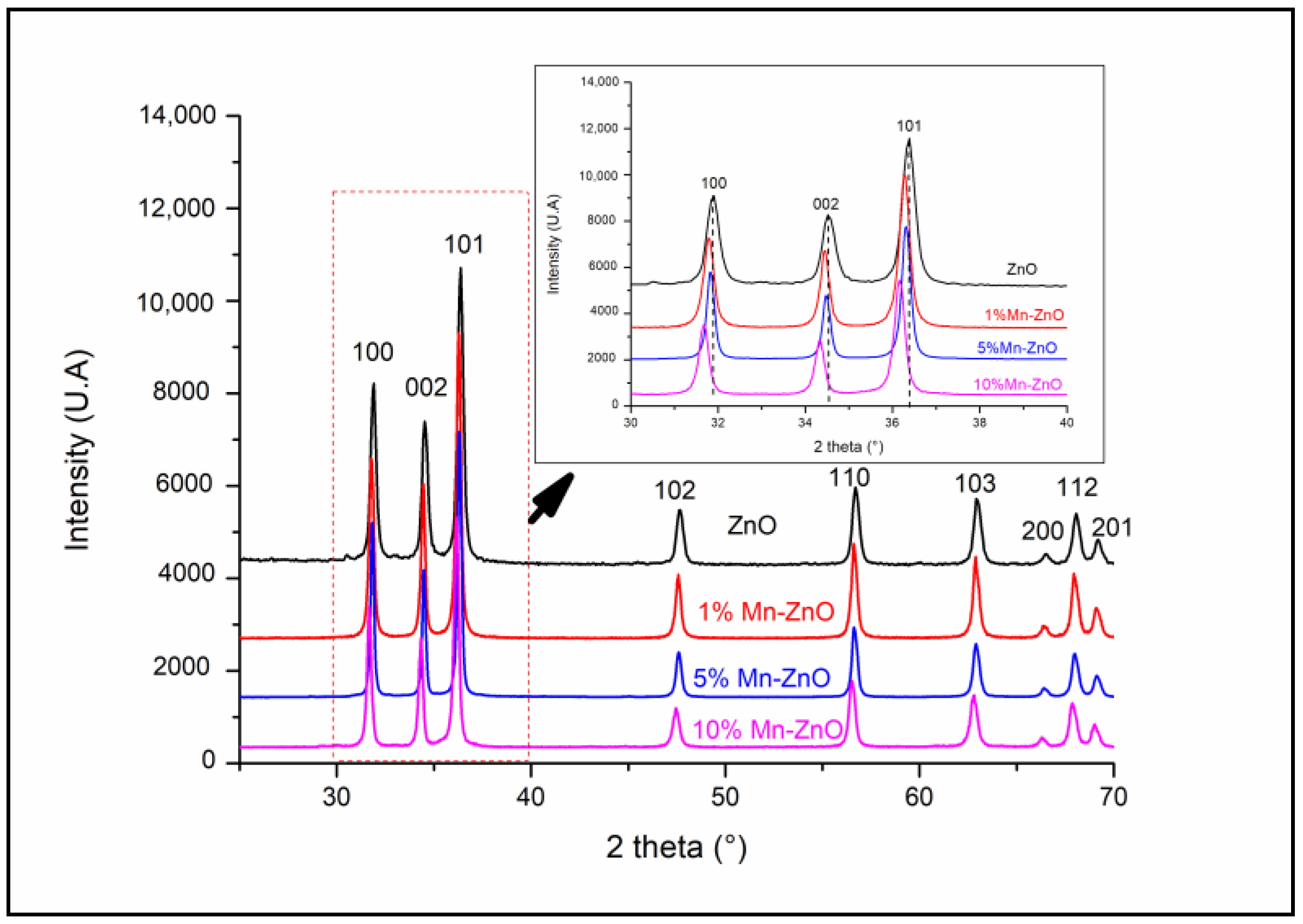
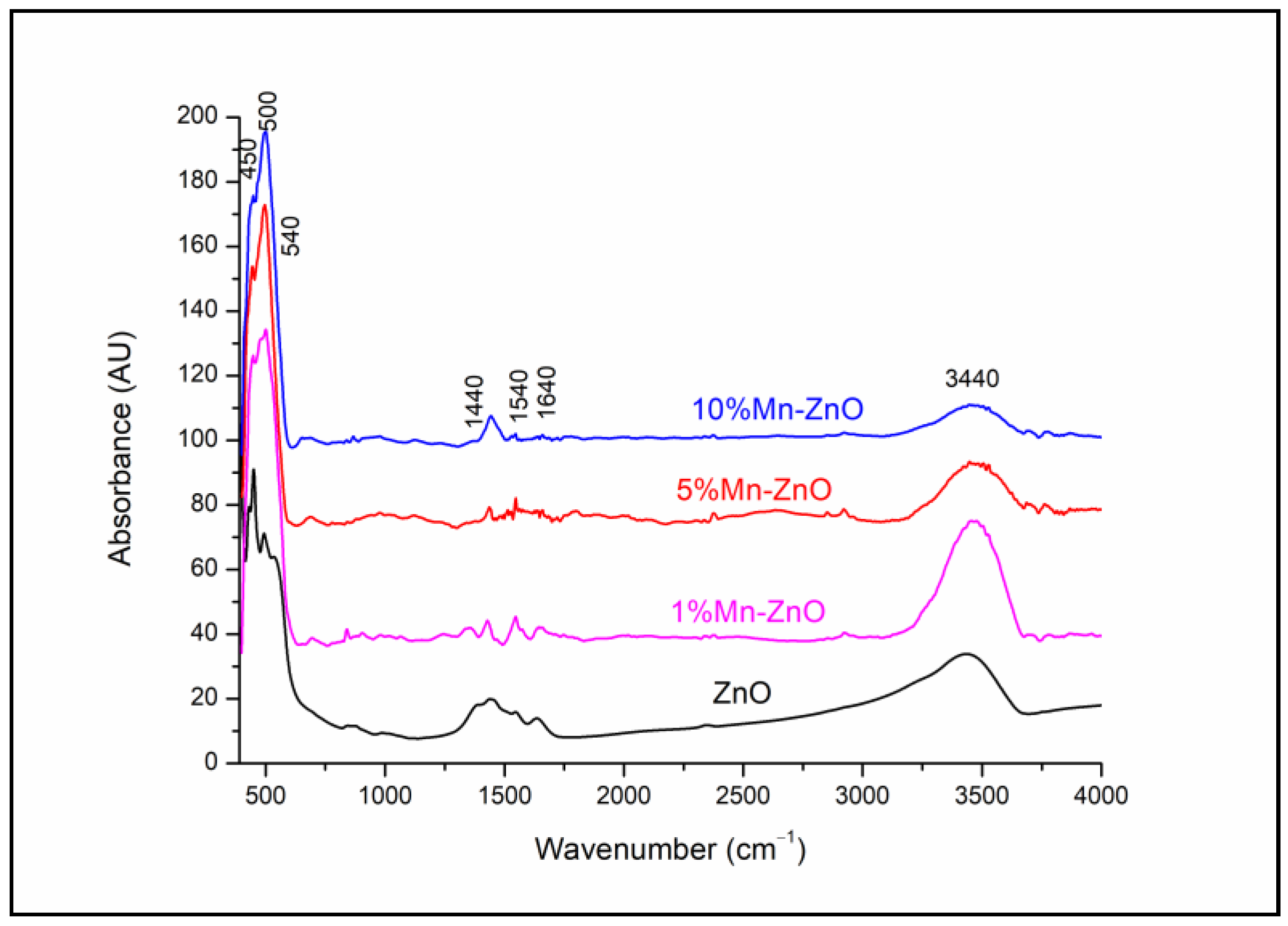


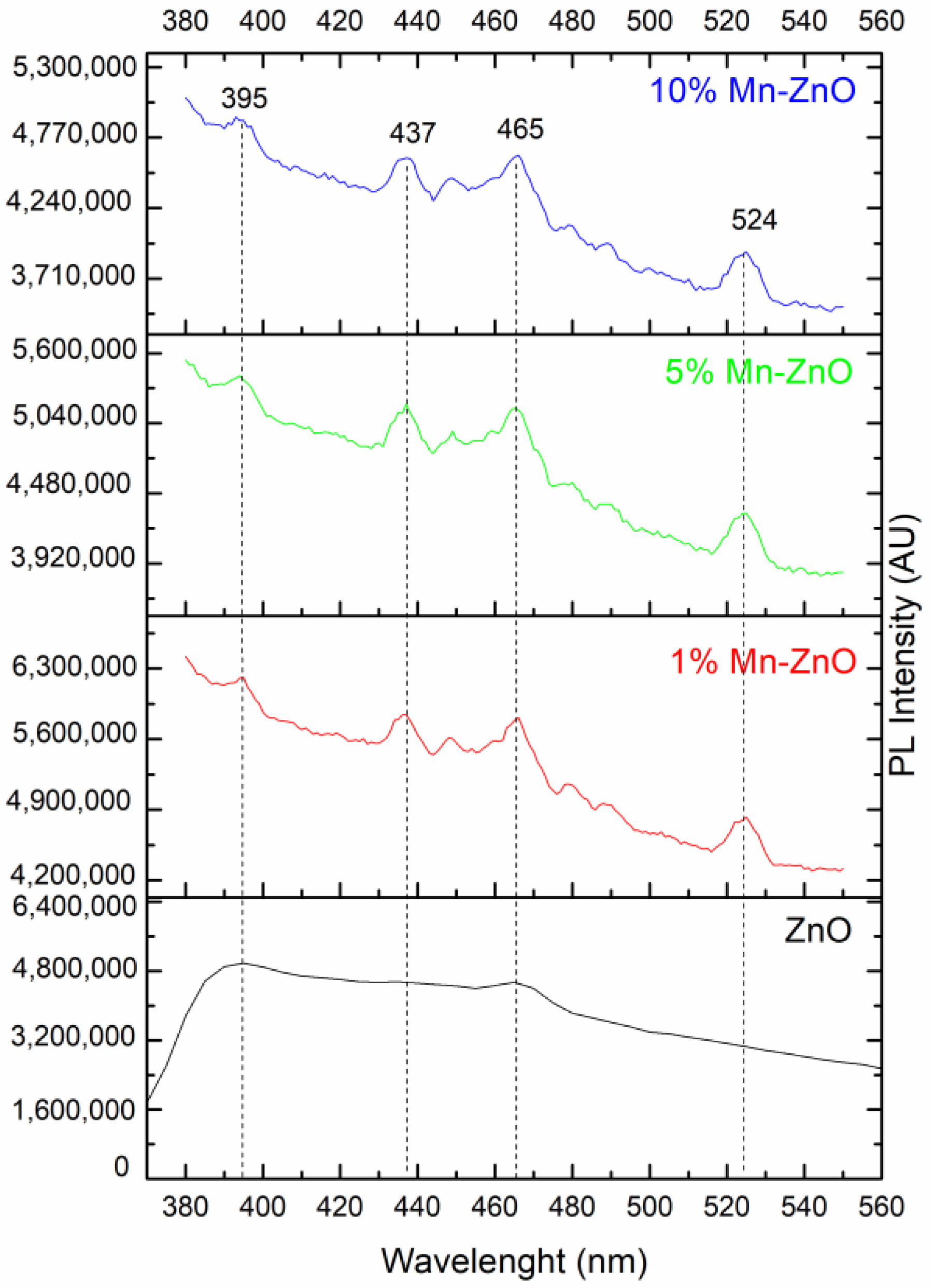


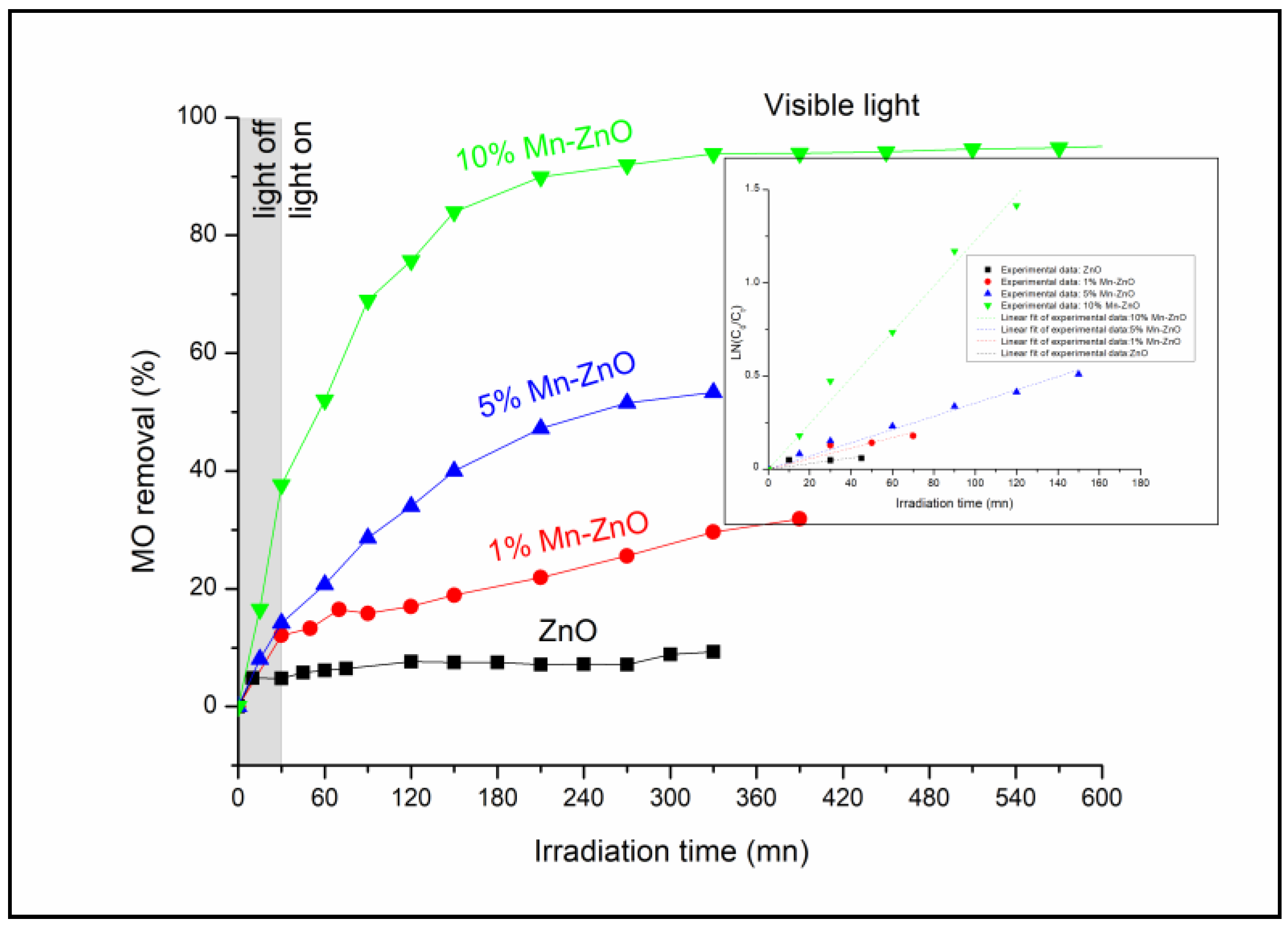
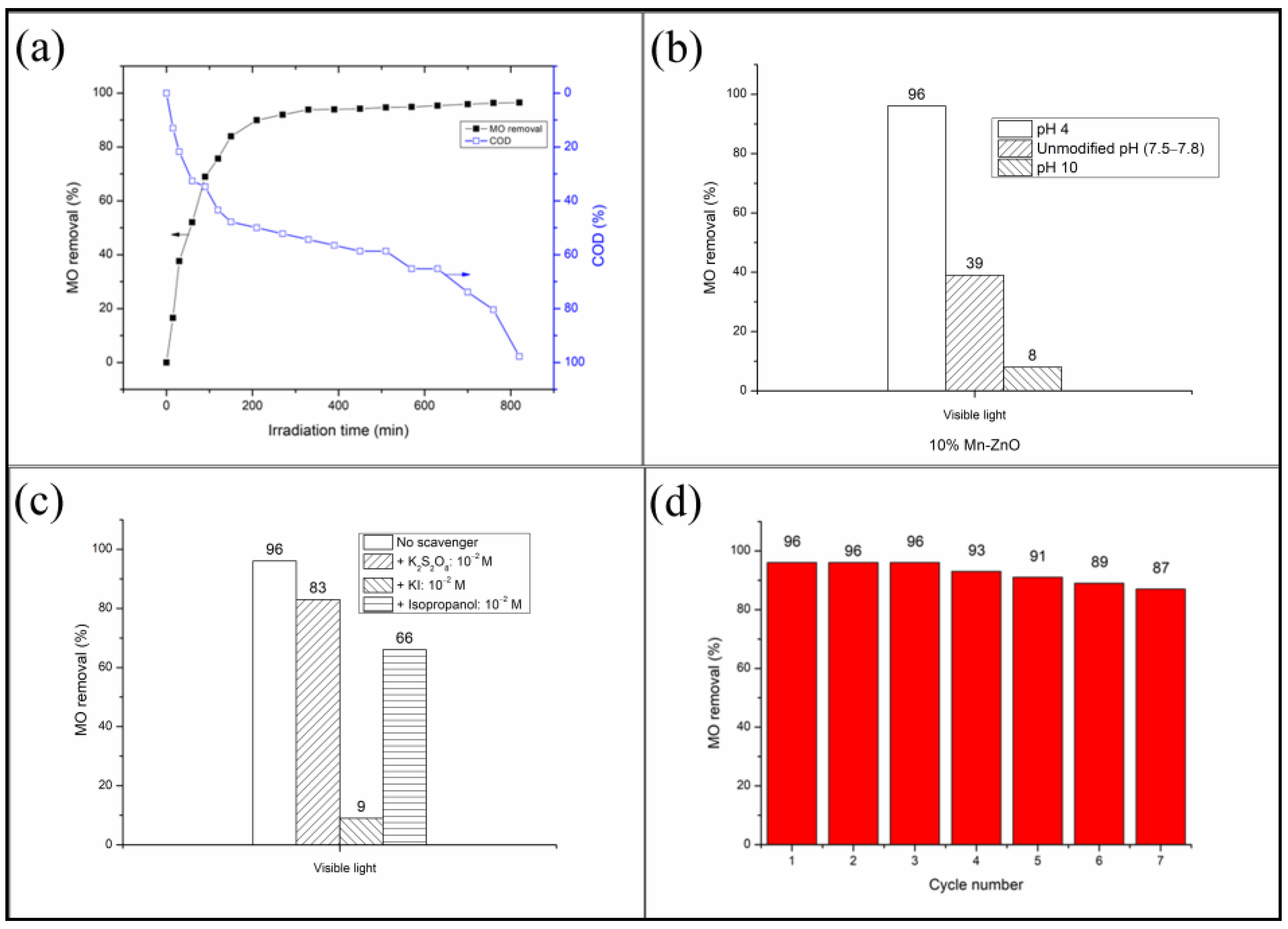
| Sample | Eg (eV) | MO Removal (%) | Rate Constant kap (min−1) | R2 |
|---|---|---|---|---|
| ZnO | 3.09 | 9.3 | 0.00153 | 0.7968 1 |
| 1%Mn-ZnO | 3.09 | 31.9 | 0.00284 | 0.9564 1 |
| 5%Mn-ZnO | 2.30 | 53.4 | 0.00355 | 0.9920 1 |
| 10%Mn-ZnO | 2.23 | 96 | 0.01228 | 0.9971 1 |
Publisher’s Note: MDPI stays neutral with regard to jurisdictional claims in published maps and institutional affiliations. |
© 2022 by the authors. Licensee MDPI, Basel, Switzerland. This article is an open access article distributed under the terms and conditions of the Creative Commons Attribution (CC BY) license (https://creativecommons.org/licenses/by/4.0/).
Share and Cite
Aadnan, I.; Zegaoui, O.; El Mragui, A.; Daou, I.; Moussout, H.; Esteves da Silva, J.C.G. Structural, Optical and Photocatalytic Properties of Mn Doped ZnO Nanoparticles Used as Photocatalysts for Azo-Dye Degradation under Visible Light. Catalysts 2022, 12, 1382. https://doi.org/10.3390/catal12111382
Aadnan I, Zegaoui O, El Mragui A, Daou I, Moussout H, Esteves da Silva JCG. Structural, Optical and Photocatalytic Properties of Mn Doped ZnO Nanoparticles Used as Photocatalysts for Azo-Dye Degradation under Visible Light. Catalysts. 2022; 12(11):1382. https://doi.org/10.3390/catal12111382
Chicago/Turabian StyleAadnan, Imane, Omar Zegaoui, Abderrahim El Mragui, Ikram Daou, Hamou Moussout, and Joaquim C. G. Esteves da Silva. 2022. "Structural, Optical and Photocatalytic Properties of Mn Doped ZnO Nanoparticles Used as Photocatalysts for Azo-Dye Degradation under Visible Light" Catalysts 12, no. 11: 1382. https://doi.org/10.3390/catal12111382




